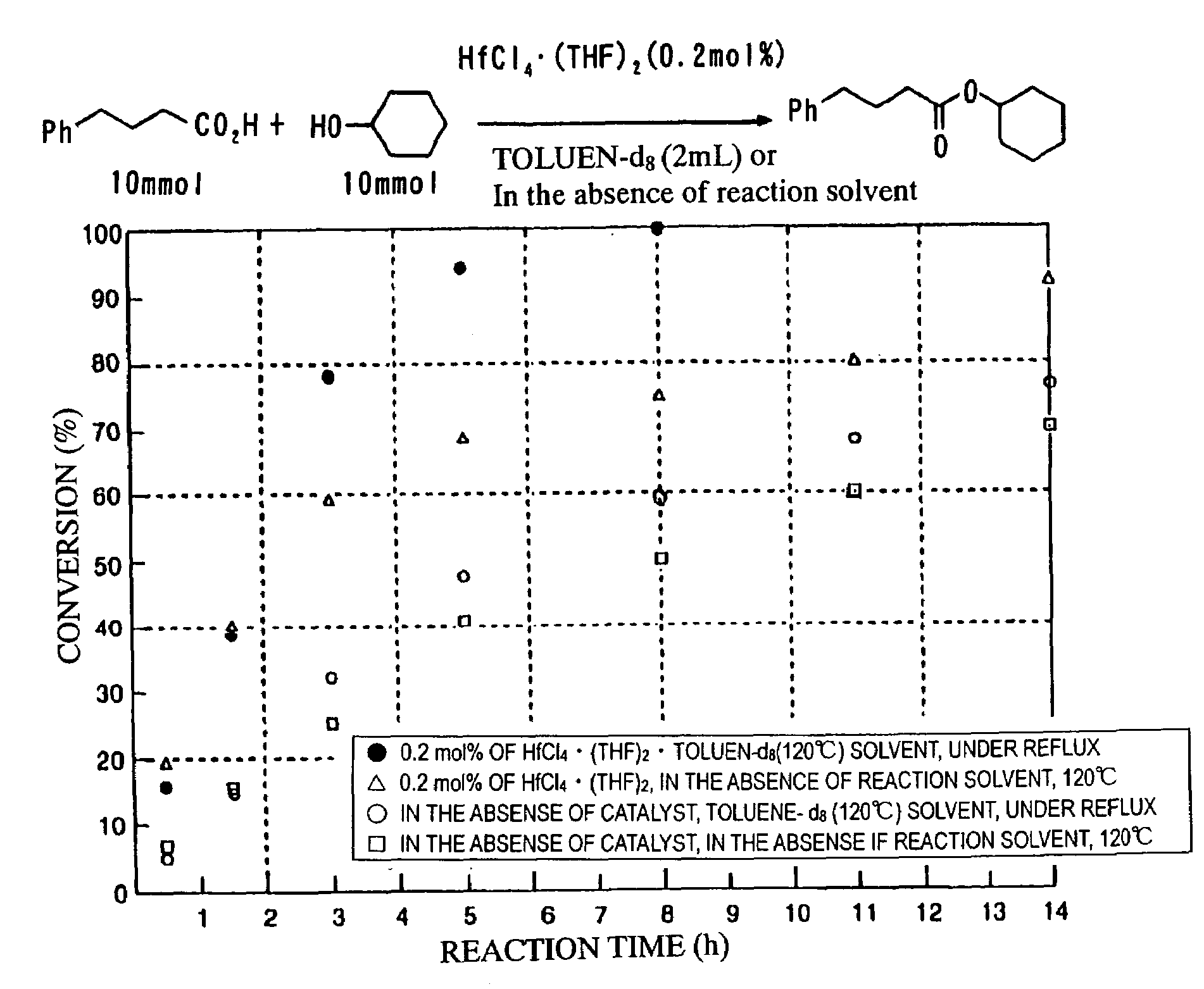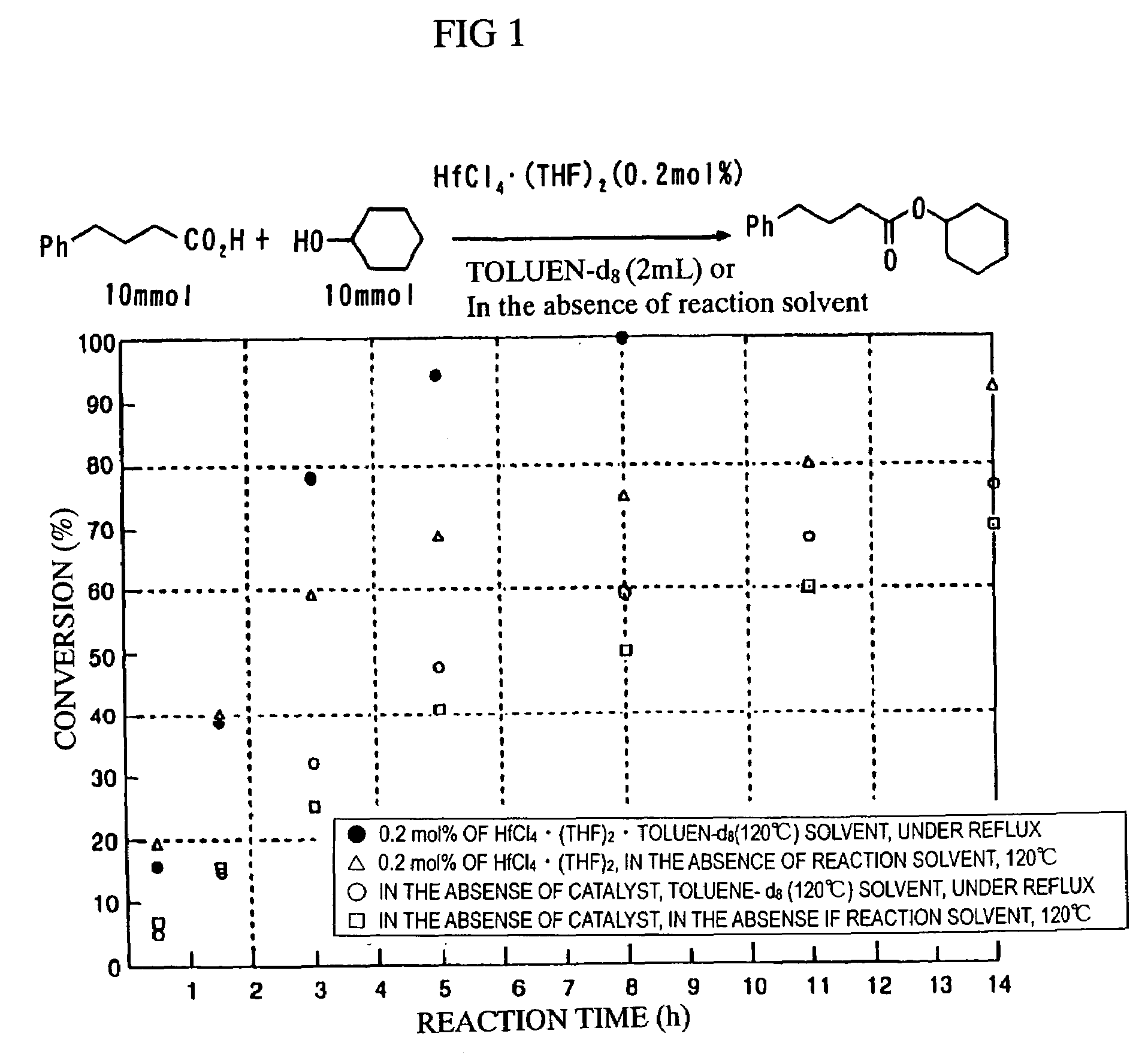Method for preparing ester condensate
a technology of ester condensate and condensate, which is applied in the direction of organic compound/hydride/coordination complex catalyst, physical/chemical process catalyst, organic chemistry, etc., can solve the problem of complicated operation of separation and purification, and achieve the effect of simple operation
- Summary
- Abstract
- Description
- Claims
- Application Information
AI Technical Summary
Benefits of technology
Problems solved by technology
Method used
Image
Examples
example 1
Selection of Tetravalent Hafnium Compound
[0020]The esterification reaction of 4-phenyl butanoic acid (1 equivalent) and benzyl alcohol (1 equivalent) in a toluene solvent (5 ml) was selected as a model reaction, and under the argon atmosphere, heating reflux at 120.degree. C. for 1.5 hours was conducted and the catalyst activity of various metallic salts (10 mol %) were compared (reaction condition A). The water generated by the reaction was removed by the calcium hydride in the Soxhlet tube attached to the top of the reaction flask. The results are shown in Table 1. The hafnium chloride (IV) and the zirconium chloride (IV) (Chem. Lett. 1981, 1671, 1981; Bull. Chem. Soc. Jpn. 62, 2353, 1989) showed a similar high catalyst activity against this esterification reaction. The hafnium (IV) t-butoxide also showed a similar high catalyst activity, but the zirconium (IV) ethoxide was inactive. The test was also executed for titanium (IV) salt (Jpn. Patent Appl. 1980, No. 55-115570, Japanese...
example 2
Optimization of the Reacting Solvent
[0023]To remove the water produced in the reaction and to optimize the reacting solvent, the variation per hour of the esterification reaction was observed by changing some reaction conditions such as the presence or the absence of the reacting solvent, with the esterification reaction of 4-phenyl butanic acid and cyclo hexanol, under the presence of 0.2 mol % (9.3 mg) of hafnium chloride(IV)·(THF)2. The results are shown in Table 1. The direct condensation reaction of 4-phenyl butaonic acid and cyclohexanol produces cyclohexyl-4-phenylbutyrate, and the conversion rate of said cyclohexyl-4-phenylbutyrate was obtained by 1H NMR analysis. From these results, it was found that it is the best method to use toluene solvent to conduct heating reflux, and to dehydrate azeotropic water with calcium hydride or molecular sieves 4A in the Soxhlet tube attached to the top of the reaction flask. On the other hand, when the reacting mixture was heated without u...
example 3
Scope of Substrate Application
[0024]By combining diversely the carboxylic acid of various structure and alcohol, the scope of substrate application of the tetravalent hafnium compound was examined. A Soxhlet tube filled with dried molecular sieves 4A (about 1.5 g) was connected to the top of a 5 ml eggplant flask contained with a teflon coated magnetic stirrer, and a cooling tube was further attached over said Soxhlet tube. Unless there is a particular point of concern, toluene solvent (2 ml) and 0.1 mol %, 0.2 mol % or 1 mol % of hafnium chloride (IV)·(THF)2 were added to carboxylic acid (10 mmol) and alcohol (10 mmol), and heating reflux was conducted in the argon for several hours at 120.degree.C. After the reaction, the mixture solution was purified by direct silica gel column chromatography (eluant hexane:ethyl acetate=4:1 to 8:1), and the solution was dried under reduced pressure. The results are shown in Table 2. In Table 2, the following are shown: for the experiment of Entr...
PUM
| Property | Measurement | Unit |
|---|---|---|
| Fraction | aaaaa | aaaaa |
| Fraction | aaaaa | aaaaa |
| Fraction | aaaaa | aaaaa |
Abstract
Description
Claims
Application Information
 Login to View More
Login to View More - R&D
- Intellectual Property
- Life Sciences
- Materials
- Tech Scout
- Unparalleled Data Quality
- Higher Quality Content
- 60% Fewer Hallucinations
Browse by: Latest US Patents, China's latest patents, Technical Efficacy Thesaurus, Application Domain, Technology Topic, Popular Technical Reports.
© 2025 PatSnap. All rights reserved.Legal|Privacy policy|Modern Slavery Act Transparency Statement|Sitemap|About US| Contact US: help@patsnap.com



